Once upon a time, root cellars were the only way people had to preserve their food. These wonderful cold-storage areas became less common when refrigerators became affordable. Houses were no longer automatically built with a root cellar beneath them or nearby.
A root cellar is still a great way to store fruits and vegetables though, especially when you need to store more than you have room for indoors. They will also keep fruit and vegetables fresh without electricity. If your house doesn’t have one you can still take advantage of “nature’s ice box.” All it takes is a shovel, a little elbow grease, and a barrel.
Building your own modern mini root cellar will only take a few hours. You will need the following:
- Shovel
- Barrel (galvanized steel or plastic)
- Drill and screws or hammer and nails
- Straw
- Rocks
- Plywood
First you will have to dig a hole in the ground, taking into consideration the dimensions of the barrel and the rocks you’ll put underneath it. After you dig the hole, make sure the top of the barrel is at the freeze line or below.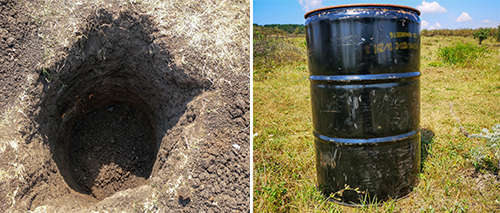 Place the barrel in the hole. Add your fruits and vegetables, put straw between them like you can see in the pictures, and then close the lid.
Place the barrel in the hole. Add your fruits and vegetables, put straw between them like you can see in the pictures, and then close the lid.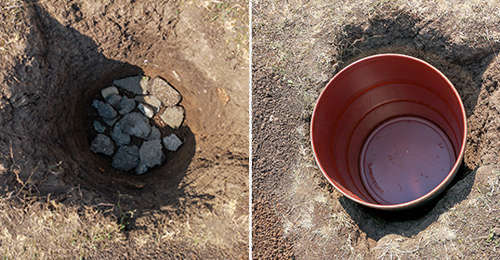
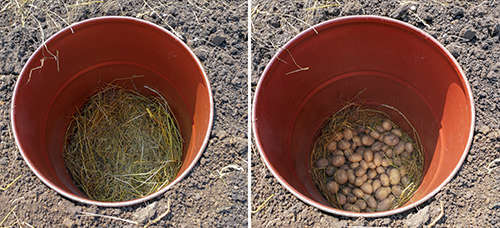 Do not use the same root cellar for both fruits and vegetables. They should not be stored together within the same barrel, even if they are separated with straw. Fruits give off ethylene, which will cause vegetables to ripen and rot. It also causes potatoes to sprout.Here you have a list of vegetables that store well together within the same barrel at 32—40°F (0—4°C) at 90—95% humidity. You can also find the length of time they can be stored for:
Do not use the same root cellar for both fruits and vegetables. They should not be stored together within the same barrel, even if they are separated with straw. Fruits give off ethylene, which will cause vegetables to ripen and rot. It also causes potatoes to sprout.Here you have a list of vegetables that store well together within the same barrel at 32—40°F (0—4°C) at 90—95% humidity. You can also find the length of time they can be stored for:
- Beets: 3—5 months
- Brussels sprouts: 3—5 weeks
- Cabbage: 3—4 months
- Carrots: 4—6 months
- Cauliflower: 2—4 weeks
- Celery: 2—3 months
- Endive: 2—3 weeks
- Kale: 10—14 days
- Leeks: 1—3 months
Do not store damaged vegetables, but do leave them dirty. Just brush off most of the dirt. Do not rinse them or wash them. Use any damaged fruits and vegetables right away. Bacteria and fungus will quickly take hold on bruised or cut produce.
Store onions in a cool, dry root cellar with temperatures of 32—35°F (0—1°C) and 60—70% humidity after you shock them. Shock them by bending or snapping the green stems one month before harvest. You can store peas with onions.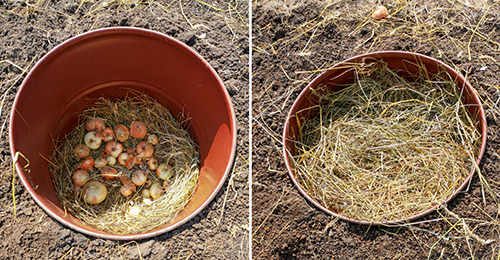 Regular potatoes and sweet potatoes need to be stored separately. Regular potatoes should be kept at 38—40°F (3—4°C) and 80—90% humidity. Sweet potatoes should be kept at 50—55°F (10—13°C) with 80—90% humidity.
Regular potatoes and sweet potatoes need to be stored separately. Regular potatoes should be kept at 38—40°F (3—4°C) and 80—90% humidity. Sweet potatoes should be kept at 50—55°F (10—13°C) with 80—90% humidity.
Dried beans need to be kept cool and dry, at temperatures between 32—50°F (0—10°C) 60—70% humidity.
Pumpkins and squash can be stored together in a warm, dry root cellar. Temperatures should be kept between 50—55°F (10—13°C) with 60—75% humidity.
Store apples and pears in a cold, moist root cellar with temperatures of 32—40°F (0—4° C) in 80—90% humidity.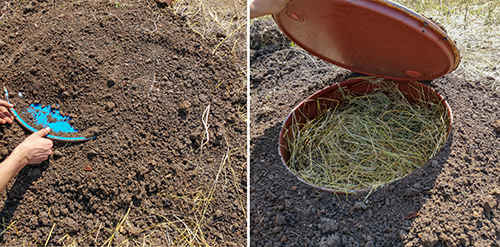 If you notice your fruits or vegetables beginning to shrivel, the humidity level is too low. Try misting the layers of straw with a little water to increase moisture levels. If there is a little condensation or moisture on the fruits or vegetables, you will need to reduce the humidity in the root cellar. Replace the straw with fresh, dry straw, and make sure there isn’t standing water beneath the barrel. You may have to move the barrel if there is standing water in the hole.
If you notice your fruits or vegetables beginning to shrivel, the humidity level is too low. Try misting the layers of straw with a little water to increase moisture levels. If there is a little condensation or moisture on the fruits or vegetables, you will need to reduce the humidity in the root cellar. Replace the straw with fresh, dry straw, and make sure there isn’t standing water beneath the barrel. You may have to move the barrel if there is standing water in the hole.
After you add all your vegetables, just put the barrel’s cap back in place. Then add some soil over the top of it.
You may also like:
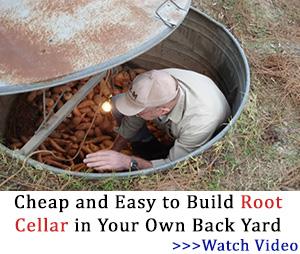 50 Foods to Dehydrate for Your Stockpile
50 Foods to Dehydrate for Your Stockpile
3 Food Items to Hoard (Video)

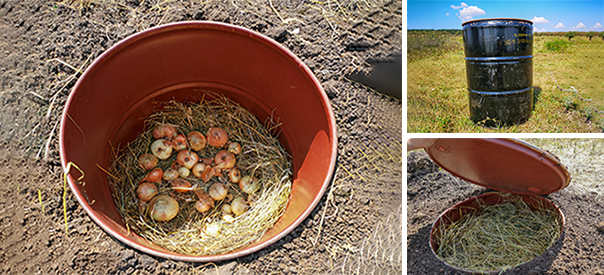




















As so many of your suggestion do … this one sounds great, but it would not work in Florida where the hole would be full of water and the barrel would rust out.
Can you please do some suggestions and directions for things for those of us who live in very wet areas?
place your root cellar above the ground in florida!
place some rocks or pieces of wood on the ground, pile high as you wish. place your barrel on top in any position that makes it convenient to access the contents. then cover with straw or dirt and add a covering tarp or plastic before covering completely. in florida your temps will not be cold enough for very long storage so best bet would be to build a spring house.
Can you store vegetables and fruits in a crawl space?
The plastic barrels would be fine in Florida, no rust problems.
Que le parece mi sugerencia, porque ud. no hace las acciones pertinentes de prueba y error, despues las comparte con todos nosotros. ¿ Porque esperar que otro haga las cosas por nosotros?
manuel:¿Cómo va? Es por eso que estamos aquí, para aprender y enseñar, para discutir, para prepararnos mejor de lo que ya sabemos. La paz de Dios para ti. caminar en la belleza.
WHAT
Assuming you live in the USA, you should do this in English, the best that you can manage to do. You must work on speaking the national language, whether it is mandatory or not.
English, please.
I have never seen a plastic barrel rust! lol
Victor: True, but rodents gnaw into them, age catches up with them (tho they likely last longer in-ground than steel 🙂 and so on. Both plastic and steel leach, but which is healthier, a little extra iron or plastic? niio
From the pictures, the barrel is far from down to the Frostline. It shows the top of the barrel at ground level.
Frostline depends on what location you are in.
Back To Map
Montana Extreme Frost Line Penetration (in inches)
State Average Frost Depth: 61″ Depending on location, Billings is 36″
Not a very good explanation, put in the straw like you see in the picture? Where is the freeze line?What are the rocks for?It seems to skip several important pieces of information
I LIVE 25 MILES SOUTHWEST OF CLEVELAND OHIO. I HAVE HAD BARN WATER HYDRANTS AND PIPES FREEZE AT 48 INCHES BELOW GROUND LEVEL DURING A COUPLE OF BAD COLD YEARS. BE CAUTIOUS TO BURY YOUR CACHE SUFFICIENTLY DEEP TO SURVIVE YOUR ANTICIPATED COLD CONDITIONS.
YEA AND GOOD LUCK TRYING TO GET IT OUT AFTER FREEZE
Pipes properly installed in Ohio won’t freeze that far below ground level; cold spells don’t last long enough for that, not even in Wyoming where I live. If that 48″ happened in Ohio the pipes had to have been exposed and not protected by soil around them.
It is highly recommended that you place your barrels underground at an angle. Three years ago a woman in our community who had food storage placed in barrels at ground level fell head first in one of her barrels and could not get under her own power.. She was found 7 days later and the coroner said she passed on the 5th day based of estimates dehydration and hypothermia. It can be a danger to anyone including children to senior citizens, small animals, etc. if the lid is opened or jarred loose.
I know it sounds crazy but it’s something to think about
Response to Martini. Here is a link to just one of many suppliers that have plastic food grade barrels. Some barrels have water tight screw on lids.
http://www.thecarycompany.com/containers/drums/plastic
Thank you so much for this link! We were just wondering where to buy some of these! You help is much appreciated. 🙂
The Romans made ice in the desert by digging a hole, placing a container of water in the bottom and then covering with their hides or capes and placing reflective shields on top toward the sun. It took about three days for the ice to form. Living in Florida as I do we probably can’t make ice this way but it might keep a barrel type root cellar at a reasonably low temp.
It says that you need plywood, a drill, and screws, but there is no explanation as to what it is for.
Ok…..how do you possibly get the products on the bottom if you are 3’ below grade plus 4’ barrel???
How about placing a disk (metal or wood?) with a rope attached that can be used to pull the products up to the surface?
32-40 degrees, sounds like a Northern America do it your self. It is 95 degrees here in Texas. We won’t see those temps but maybe three weeks during our so called winter. And not consecutively.
Living in New Mexico. To dig that size hole would take a couple of Days. We tend to grow rocks and what you thought was a rock was actually boulders. The other thing I am worried about if we were to accomplish digging the hole would be falling in to the barrel and not being able to get out. Just getting chicken feed out of a 55 gallon barrel sitting on the ground is hard enough when trying to reach the bottom. I could not imagine having this built into the ground and retrieving it.
Any other options? As we get older are bodies are not like they use to be.
In Florida we are just the opposite; all sand. My solution to this is to take the sand that is dug out of the hole, fill sandbags and use them to line the hole. I will make it deep enough that I can stand upright with a roof on it. Can’t make it too deep though or else I will hit the 68F groundwaterr.
Dig steps lol
Yeah, just keep your refridg,
yes how to get stuff out?
Plastic Barrels with a rubber ring to seal them from water, bugs, etc. is the answer.
You must bury them in a hillside or a mound at an angle like 45 degrees, so you fall inside, you can back out.
In areas of severe frost either burying them deeper of mounding them with soil of better yet a compost pile because a compost pile creates heat in decomposition cycles. It would take 3 to 5 feet of compost above at at least that depth 5 feet round the perimeter of the barrel. Cover it black plastic and pile more soil or compost on top. Old carpet well as an additional insulator.
Another solution is to bury an old refrigerator or freezer on on it’s backside level with the ground. Put an old exhaust or intake manifold, or bricks or some other potential heat sink inside. Wrap it with heat tape and you can plug it in in severe weather or to just keep it above freezing. Bury the door in same manner as discussed above.
I don’t believe article was supposed to a “cure all” for every environment. One must get creative, use a little common sense, and accept the fact that you are responsible for your own food storage and survival.
Hope this helps.
This sounds like a tiger trap, and you’re the tiger. If anyone tries this idea, don’t fall in. Invent a way to get the food out. Without thinking much about it, I would think you would need to put the veggies in five gallon buckets with a way to hoist them out. The buckets could then be rotated and sorted.
As stated by several, this method would have problems in northern climes where the frost line is 48″ +/-, then the depth of your barrel.
A possible solution – more work, but more accessible – use 5 gallon buckets with rubber gasket seal lids & handles; tie a rope, etc. on handles to pull up. You could double stack buckets; make multiple holes and put one or two types of veggies (or fruit) in each one. Make sure hole diameters are large enough to allow easy movement up & down.
Here in Michigan, frostline is 48″, and in some areas you may hit ground water digging deeper. If that’s a problem, try shallower hole, and mound earth above holes/ground level.
This reminds me of how some people in other countries minus a ref keep food cool they take clay pots put food in one put that in a bigger pot with sand and wet the sand to keep it cool [ one must keep the sand wet though ] and that is their ref. Now speaking of this well i would go with 5 gal buckets because it is easier to lift and reach the bottom. One other thing i would think of doing is adding straw around the outside of the bucket or leaves etc maybe straw would be better as it would be easier to pull the bucket out and the hole doesn’t cave in not sure .Or like the ref thing one could put sand in the hole after having a bigger bucket one could put the second bucket in this way one would not need to worry of the sand caving in and could just pull say the 5 gal one out to get to the food . Now someone stated an ole ref oh yes i have heard of this too , what one does is dig into a hill put the ref in it with the front being open where the door is and store food this way . One other thing i would think of doing is not to mix any of the product so like one bucket has just potatoes another has cabbage or something ,etc then one does not have to dig to get say potatoes by taking out say the cabbage first .
Yes, it’s called a ZEER POT. One thing to keep in mind is that if you are using dirty water, the foods may end up dirty as well as it could leak after some time of use.
Not mixing produce in the buckets is an excellent idea. However, keep in mind that all that produce MUST have enough air circulation to keep it all from spoiling. Ethylene gas from certain fruits and vegetables will cause other to ripen and spoil faster.
Above ground root cellars are easier than digging holes. Our soil goes down 3 feet, then we hit sandstone. anything made of lime averages 10 F less than the air around it, which is why mortuaries used marble slabs.
We used to store sweet potatoes in buckets of dirt, and they kept well in the kitchen all winter. niio
What do you do for a person who lives in Arizona and has rocky ground? All my garden is either in containers or raised beds as the ground is too rocky to dig into.
birderrose: I live in the San Pedro valley and our soil is high in caliche. It took 2 years, but I managed to wear out both a pick and a shovel. 3 feet deep, 3 wide, and up to 25 long. And, I’m still picking at it, no pun intended. If you have caliche, remember, nothing will root into it. If you want the break-back work, then trench like the Indians here taught me to. I back-fill with a lot of brush and weeds and cactus, then dirt mixed with coffee grounds (a la starbucks) to keep the adobe from turning into a brick, again. Most of the rock was tossed to one side, but there’s so little, it wasn’t worth collecting. Caliche went in the alley out back where it makes a good road base. Did you get any rain? We’;re way below average. Even the prickly pears are wilting.
I am in NH where the winters get to be below zero some nights, then if we are lucky the temp may actually go up to zero. That is around Jan & Feb the rest of the winter is either lots of snow/ice or freezing rain. There is no constant pattern. The ground here is ledge. So what would you suggest . . . ?
I invite you to do this in my backyard in Arizona. I wore out a pick just starting the garden LOL. Happy New Year. niio
This article provides a practical and efficient method for constructing a mini root cellar in your backyard using simple materials like a barrel and straw. The step-by-step guide makes it accessible for anyone looking to preserve fruits and vegetables without relying on electricity. I appreciate the detailed storage tips, especially the emphasis on separating fruits and vegetables to prevent spoilage. This DIY project is a valuable addition to sustainable living practices.